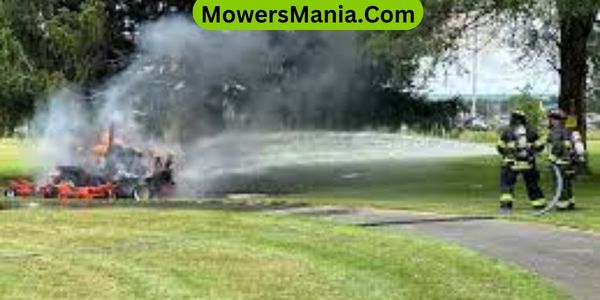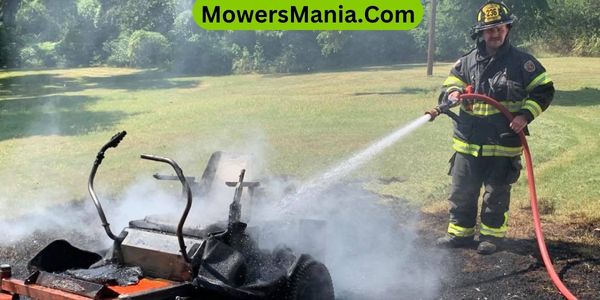When your lawn mower starts sputtering and smoking like a tired old engine, it might be overheating. Don’t panic. You can cool it down and get it running smoothly again with a few simple steps.
In this guide, you’ll learn how to recognize the signs of an overheated mower, ensure proper ventilation, check and clean the cooling system, and perform essential maintenance to keep it running smoothly.

By adjusting your mowing techniques and taking care of your mower, you can keep it from overheating and ensure it stays in top condition for years to come.
Signs of Lawn Mower Overheating
If your lawn mower is overheating, it will exhibit warning signs such as excessive smoke, a hot engine, and a burning smell. When you notice these signs, it’s crucial to address the issue promptly to prevent any further damage to your equipment.
Excessive smoke coming from the lawn mower indicates that the engine is running too hot, often caused by a lack of oil or a dirty air filter. A hot engine that feels unusually warm to the touch is another sign of overheating and shouldn’t be ignored. Additionally, a burning smell emanating from the mower suggests that some components may be overheating or even melting.
These warning signs indicate that immediate action is necessary to prevent more severe problems and ensure the longevity of your lawn mower. Ignoring these indicators can lead to costly repairs or even the need for a new mower altogether.
Proper Ventilation for the Mower
To ensure proper ventilation for your mower, routinely check and clean the air filter to prevent overheating.
Additionally, regularly inspect the cooling fins and ensure they’re free from debris buildup, as this can impede airflow and contribute to the mower’s overheating.
- Inspect the Air Filter: Start by locating the air filter, usually housed in a plastic or metal casing near the carburetor. Remove the cover and inspect the filter for dirt, dust, and debris. If dirty, gently clean it with compressed air or wash it with soap and water. Allow it to dry completely before reinstalling.
- Check the Cooling Fins: Locate the cooling fins, which are thin metal pieces surrounding the engine. Ensure they’re free from grass clippings, dirt, and debris. Use a brush or compressed air to remove any buildup, taking care not to bend or damage the fins.
- Clear the Ventilation Openings: Look for ventilation openings on the engine cover and housing. Keep these areas free from obstructions, such as grass clippings and dirt, to maintain proper airflow.
- Inspect the Muffler: Check the mower’s muffler for debris accumulation, as this can also impede proper ventilation. Clear any buildup to ensure efficient airflow and heat dissipation.
Checking and Cleaning the Cooling System

Ensure that you routinely inspect and clean the cooling system of your lawn mower to prevent overheating and maintain optimal performance.
Start by checking the air intake and cooling fins for any debris or grass clippings that may have accumulated. Use a soft brush or compressed air to gently remove any buildup, ensuring that the airflow remains unobstructed.
Next, examine the cooling fan to make sure it’s free of dirt and spins properly. Clean the fan blades and the surrounding area to promote efficient cooling.
Additionally, inspect the engine shroud or cover to ensure that it’s intact and properly installed, as it directs airflow over the engine to aid in cooling.
Lubrication and Maintenance Tips
Regular maintenance of the lubrication system is essential for preserving the optimal performance and longevity of your lawn mower.
Here are some crucial lubrication and maintenance tips to ensure your mower runs smoothly:
- Check the oil level: Regularly inspect the oil level and top it up as needed with the manufacturer’s recommended oil type. Low oil levels can lead to increased friction and overheating.
- Change the oil: Follow the manufacturer’s guidelines for regular oil changes. Over time, the oil can become contaminated with dirt and debris, leading to decreased lubrication effectiveness.
- Inspect and clean the air filter: A clogged air filter can restrict airflow, causing the engine to work harder and generate more heat. Clean or replace the air filter according to the manufacturer’s recommendations.
- Grease moving parts: Lubricate the mower’s moving parts such as the wheels, bearings, and joints with the appropriate grease. This helps reduce friction and prevents overheating.
Adjusting Mowing Techniques for Heat

To maintain optimal performance and prevent overheating, adjust your mowing techniques to accommodate high temperatures and reduce the strain on your lawn mower.
When the weather heats up, it’s important to adapt your mowing habits to prevent your lawn mower from working too hard and overheating.
Here are some essential tips for adjusting your mowing techniques during hot weather:
| Adjusting Mowing Techniques for Heat | Tips and Tricks |
|---|---|
| 1. Time of Day | Mow in the early morning or late evening to avoid the peak heat of the day. |
| 2. Mowing Height | Raise the cutting height of your mower to reduce stress on the grass during hot weather. |
| 3. Sharpen Blades | Regularly sharpen your mower blades to ensure clean cuts that minimize stress on the grass. |
| 4. Alternate Patterns | Change your mowing pattern regularly to prevent soil compaction and stress on the turf. |
Frequently Asked Questions [FAQs]
Can I Use a Fan to Cool Down My Overheated Lawn Mower?
Yes, you can use a fan to cool down your overheated lawn mower. Simply place the fan near the mower’s engine to help dissipate the heat. Make sure to let the mower cool down completely before attempting to use it again.
Is It Safe to Pour Cold Water on a Hot Lawn Mower to Cool It Down?
Yes, it’s safe to pour cold water on a hot lawn mower to cool it down. Avoid using hot or warm water as it can damage the engine. Let the mower cool down for a few minutes before resuming.
How Often Should I Replace the Air Filter in My Lawn Mower to Prevent Overheating?
You should replace the air filter in your lawn mower at least once a season to prevent overheating. A clogged air filter can restrict airflow, causing the engine to work harder and potentially lead to overheating.
Are There Any Specific Types of Oil or Lubricants That Are Better for Preventing Overheating in a Lawn Mower?
For preventing overheating in a lawn mower, it’s best to use high-quality, synthetic oil or lubricants specifically designed for small engines. These products provide better heat resistance and reduce friction, helping to prevent overheating issues.
Can Mowing in the Early Morning or Late Evening Help Prevent My Lawn Mower From Overheating?
Mowing in the early morning or late evening can help prevent your lawn mower from overheating. The cooler temperatures during these times reduce strain on the engine and decrease the risk of overheating.
Conclusion
So, if your lawn mower starts to overheat, make sure to give it a break and allow it to cool down before using it again.
Keep the cooling system clean and well-maintained, and adjust your mowing techniques for hot weather.
By following these tips, you can prevent overheating and keep your lawn mower running smoothly all season long.



